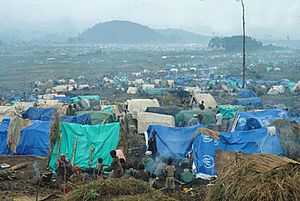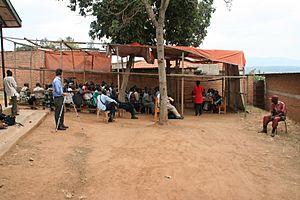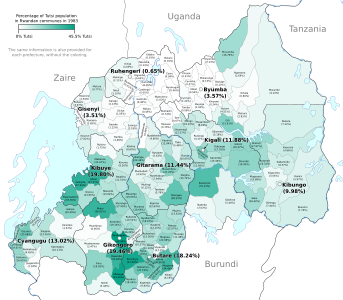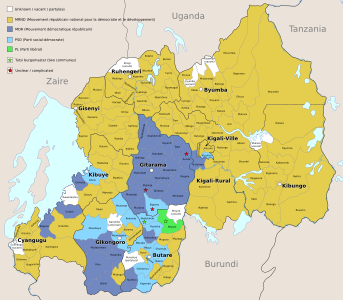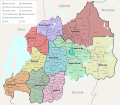Rwandan genocide facts for kids
Quick facts for kids Rwandan genocide |
|
|---|---|
| Part of the Rwandan Civil War | |

Rwandan Genocide Memorial, Geneva
|
|
| Location | Rwanda |
| Date | 7 April – 15 July 1994 |
| Target | Tutsi population and moderate Hutus |
|
Attack type
|
Genocide, mass murder |
| Deaths | Estimated: 491,000–800,000 (Tutsi only) |
| Perpetrators |
|
| Motive | Anti-Tutsi racism, Hutu Power |
The Rwandan genocide was a terrible event that happened in Rwanda between April 7 and July 15, 1994. This period lasted about 100 days. During this time, many people from the Tutsi group were killed. Some people from the Hutu and Twa groups who did not agree with the killings were also targeted. Armed groups, mostly Hutu militias, were responsible for these deaths. Experts believe that between 500,000 and 800,000 Tutsi people lost their lives.
Contents
How the Rwandan Genocide Started
In 1990, a rebel group called the Rwandan Patriotic Front (RPF) started the Rwandan Civil War. This group was made up mostly of Tutsi refugees living in Uganda. They invaded northern Rwanda. For three years, neither side could win the war.
To try and end the fighting peacefully, the Rwandan government signed an agreement. This agreement was called the Arusha Accords. It was signed on August 4, 1993, by the Hutu president, Juvénal Habyarimana, and the RPF.
However, on April 6, 1994, President Habyarimana was killed. His plane was shot down. This event caused a lot of chaos and ended the peace agreement. The very next day, the killings began. Hutu soldiers, police, and militias started murdering important Tutsi and moderate Hutu leaders.
The world was shocked by how many people were killed and how brutally it happened. But no country stepped in with force to stop the killings. Most victims were killed in their own towns or villages. Many were killed by their own neighbors. Hutu groups searched for people hiding in churches and schools.
The RPF quickly started fighting again once the genocide began. They took control of all government areas. This stopped the genocide. The former government and those who committed the killings were forced to flee to Zaire (now called the Democratic Republic of the Congo).
The genocide had long-lasting effects on Rwanda. In 1996, the RPF-led government went into Zaire. This started the First Congo War. Today, Rwanda has two public holidays to remember the genocide. It is also against the law to deny the genocide happened or to cause division among people.
Rwanda After the Conflict
After the RPF won, many Hutu people fled to refugee camps. These camps were mostly in eastern Zaire (now the Democratic Republic of the Congo). Some of the people who had committed the genocide also went to these camps. They started to gather their forces again.
The RPF-led Rwandan government then sent its military into Zaire. They said they needed to stop more killings. This led to the First Congo War (1996–1997) and the Second Congo War (1998–2003). Fighting between the Rwandan government and its opponents has continued in the Goma region. This includes conflicts like the M23 rebellion (2012–2013). Many Rwandan Hutu and Tutsi people still live as refugees in the region.
Refugee Crisis and Congo Wars
After the RPF won, about two million Hutu people fled to other countries. They went to refugee camps, especially in Zaire. They were afraid the RPF would punish them for the genocide. The camps were very crowded and dirty. Thousands of refugees died from diseases like cholera.
The United Nations High Commissioner for Refugees (UNHCR) set up these camps. But the army and leaders of the former Hutu government controlled them. Many of these leaders had been involved in the genocide. They started to get weapons again, hoping to return to power in Rwanda.
By late 1996, Hutu fighters from the camps were attacking Rwanda. The RPF-led Rwandan government fought back. Rwanda helped a Tutsi group in Zaire called the Banyamulenge. They helped them defeat Zaire's security forces. Then, Rwandan forces and the Banyamulenge attacked the refugee camps. They targeted the Hutu fighters.
These attacks caused hundreds of thousands of refugees to flee again. Many went back to Rwanda, even with the RPF there. Others went deeper into Zaire. The Rwandan army pursued these refugees. Many Hutu refugees lost their lives during this pursuit. The defeated Hutu forces continued to attack Rwanda from across the border. But by 1999, the Rwandan government had brought Hutu people to their side. The attacks stopped.
Rwanda's leader, Paul Kagame, also planned to remove Mobutu Sese Seko from power. Mobutu was the dictator of Zaire. He had supported the groups who committed the genocide. He was also accused of allowing attacks on Tutsi people in Zaire.
Rwanda and Uganda supported four rebel groups led by Laurent-Désiré Kabila. They started the First Congo War in 1996. The rebels quickly took control of the North and South Kivu provinces. They then moved west, taking over the whole country by 1997. Mobutu fled, and Zaire was renamed the Democratic Republic of the Congo (DRC).
However, Rwanda and the new Congolese government had a disagreement in 1998. Kagame supported a new rebellion. This led to the Second Congo War. This war lasted until 2003. It caused millions of deaths and huge damage. In 2010, a United Nations (UN) report said the Rwandan army had committed serious wrongs in Congo. The Rwandan government denied these charges.
Life in Rwanda After the Genocide
Rwanda's buildings and economy were badly damaged during the genocide. Many buildings could not be used. The old government had taken all the money and movable things when they fled. Many people were also gone. Over 40% of the population had been killed or had left the country.
The army, led by Paul Kagame, kept order. The government began to rebuild the country. Aid groups started to return to Rwanda. But the world community did not give much help to the new government. Most international aid went to the refugee camps in Zaire.
Kagame wanted the new government to include everyone, not just Tutsis. He removed ethnic labels from national identity cards. The government started to reduce the differences between Hutu, Tutsi, and Twa.
Justice System After the Genocide
The justice system was almost completely destroyed during the genocide. After the genocide, over one million people might have been involved in the killings. The RPF arrested many people who were responsible. Over 100,000 people were jailed in the two years after the genocide.
Rwanda's prisons were built for about 18,000 inmates. But in 1998, there were over 100,000 people in crowded jails. This led to very harsh conditions.
Courts finally began trials for genocide cases in 1996. A new law was passed to allow this. This law started trials for genocide crimes and crimes against humanity from October 1990. The law put those involved in the genocide into four groups. The first group included the "planners, organizers, and leaders" of the genocide. It also included murderers who were especially cruel. People in this group could face the death penalty.
Rwanda had the death penalty before 1996. But no one had been executed since 1982. In April 1998, twenty-two people were executed by firing squad in public. After this, Rwanda stopped executions. In 2007, a new law ended the death penalty. All death sentences were changed to life in prison.
Gacaca Courts
Because there were so many cases, the government created a new court system in 2001. These were called Gacaca Courts. They were set up in all parts of Rwanda. Their main goal was to help the regular courts and speed up trials for those in prison. The less serious cases were handled by these Gacaca Courts.
The Gacaca court system was a traditional way of solving community problems. It was changed to deal with genocide crimes. The main goals were to find out the truth about what happened, speed up trials, bring people together, and show that Rwandans could solve their own problems.
The Gacaca courts faced many challenges. Some people said they were controlled by the RPF government. The judges were elected by the public. They received training, but some worried it was not enough for serious legal questions. Many judges resigned after being accused of taking part in the genocide. There was also a lack of lawyers for the accused. Most trials were open to the public, but witnesses sometimes felt threatened. The Gacaca courts did not try those responsible for killings of Hutu civilians by the RPF.
The Gacaca court system officially closed on June 18, 2012. It had tried almost two million cases. Over one million people stood trial.
Remembering and Preventing Genocide
The Rwandan constitution makes it a crime to deny or make light of the genocide. Hundreds of people have been tried and found guilty of "genocide ideology" or "revisionism." These laws are meant to prevent future conflicts. However, some groups have said that these laws are sometimes used to stop people from criticizing the government.
Survivors of the Genocide
The number of Tutsi survivors of the genocide has been discussed. Figures range from 150,000 to over 300,000. There are many groups that help and support these survivors. These include the Survivors Fund, IBUKA, and AVEGA. A 2007 report looked at how survivors were living in Rwanda:
| Category | Number of survivors |
|---|---|
| Very vulnerable survivors | 120,080 |
| Shelterless | 39,685 |
| Orphans living in households headed by children | 28,904 |
| Widows | 49,656 |
| Disabled during the genocide | 27,498 |
| Children and youth with no access to school | 15,438 |
| Graduates from high school with no access to higher education | 8,000 |
Media and Popular Culture About the Genocide
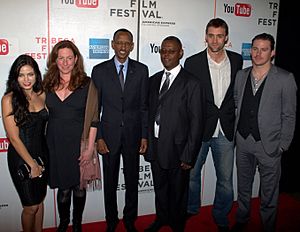
Canadian Lieutenant-General Roméo Dallaire was a well-known witness to the genocide. He wrote a book called Shake Hands with the Devil: The Failure of Humanity in Rwanda (2003). It described his experiences and struggles. His book was made into a movie called Shake Hands with the Devil (2007).
The movie Hotel Rwanda (2004) is very famous. It was nominated for many awards. The film is based on the true story of Paul Rusesabagina. He was a hotel manager in Kigali. He saved over a thousand refugees during the genocide.
The documentary film Earth Made of Glass (2010) also talks about the genocide. It focuses on Rwandan President Paul Kagame and a survivor named Jean-Pierre Sagahutu. It premiered at the 2010 Tribeca Film Festival.
HBO Films released a TV movie called Sometimes in April in 2005.
Many films about the genocide helped people understand the horror. Charlie Beckett, a director, said that Hotel Rwanda is how most people now learn about Rwanda.
Pierre Rutare, the father of Belgian-Rwandan singer Stromae, was killed in the 1994 Rwandan Genocide.
Commemoration and Remembrance
In March 2019, President Félix Tshisekedi of the Democratic Republic of the Congo visited Rwanda. He signed the Kigali Genocide Memorial Book. He said that the terrible events had also affected his country.
On April 7, the Rwandan Government started 100 days of mourning. This was to mark the 25th anniversary of the genocide. They lit a flame at the Kigali Genocide Memorial. Leaders from many countries attended the event.
Maps of Rwanda
Images for kids
-
Paul Kagame, commander of the Rwandan Patriotic Front for most of the Civil War
See also
 In Spanish: Genocidio de Ruanda para niños
In Spanish: Genocidio de Ruanda para niños
- Outline of Genocide studies


